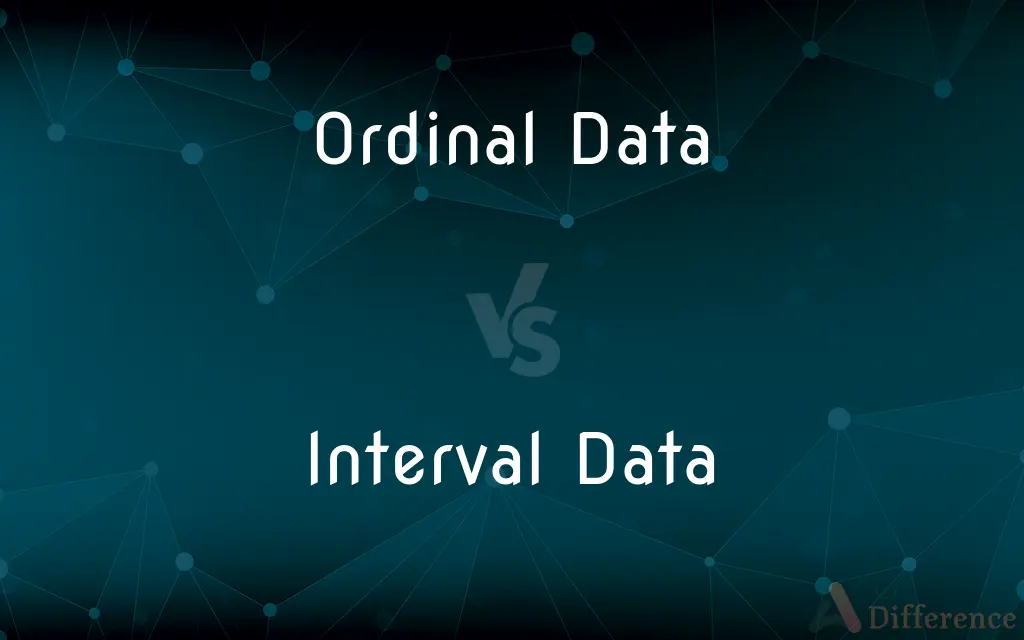Ordinal Data vs. Interval Data — What's the Difference?
By Tayyaba Rehman — Published on November 6, 2023
Ordinal Data categorizes and orders items, while Interval Data has consistent, measurable differences between values but no true zero.

Difference Between Ordinal Data and Interval Data
Table of Contents
ADVERTISEMENT
Key Differences
Ordinal Data and Interval Data are two types of data levels in statistical analysis. Ordinal Data provides a way to categorize data points and arrange them in a specific order based on their attributes. In contrast, Interval Data not only categorizes and orders data but also provides a consistent measurable difference between each data point.
While Ordinal Data can rank items, the spacing between the categories is not consistent or defined. Interval Data, however, ensures that the distance between two points is both consistent and meaningful. Nevertheless, Interval Data doesn't have a true zero point, which means it doesn't convey the absence of a quality.
To give an illustrative example: in Ordinal Data, you might rank a set of movies as 1st, 2nd, and 3rd best. You know the order, but not by how much one movie is better than the other. On the other hand, with Interval Data, if the temperature is 20°C and then 30°C, the difference is a measurable 10°C. Still, zero in Interval Data (like 0°C) doesn’t mean the absence of temperature.
In research and analysis, understanding whether you are working with Ordinal Data or Interval Data is crucial. Ordinal Data's ability to categorize and order makes it beneficial for surveys and feedback mechanisms. Interval Data's consistent differences make it valuable for analyses that require precision, like measuring temperature changes or IQ scores.
Lastly, the scales used to measure both data types differ significantly. Ordinal Data often uses scales like "low-medium-high" or "agree-neutral-disagree." Interval Data, meanwhile, employs scales with equidistant points, like the Celsius or Fahrenheit temperature scales.
ADVERTISEMENT
Comparison Chart
Nature
Categorical, ordered
Quantitative, measurable differences
Spacing
Inconsistent, undefined
Consistent and defined
Example
Rankings (1st, 2nd, 3rd)
Temperature in Celsius or Fahrenheit
True Zero Presence
Not applicable
No true zero
Typical Scales
Low-Medium-High, Agree-Neutral-Disagree
Celsius, Fahrenheit, IQ scores
Compare with Definitions
Ordinal Data
Data categorized and arranged in a specific order.
In a race, runners are placed as 1st, 2nd, and 3rd, reflecting Ordinal Data.
Interval Data
Contains no true zero point.
In Interval Data, 0°C does not mean the absence of temperature.
Ordinal Data
Has categories with a meaningful order, but not measurable distances.
The order of low, medium, and high importance is Ordinal Data.
Interval Data
Suitable for mathematical operations due to its quantitative nature.
Calculating the average temperature over a week involves Interval Data.
Ordinal Data
Often used in surveys and feedback collection.
Asking consumers to rank products from favorite to least favorite uses Ordinal Data.
Interval Data
Quantitative data with consistent, measurable differences between values.
A difference of 10 degrees between 20°C and 30°C showcases Interval Data.
Ordinal Data
Reflects rankings without consistent spacing between ranks.
Student grades of A, B, and C are Ordinal Data without precise value differences.
Interval Data
Differences between data points are uniform and meaningful.
The consistent gap between IQ scores, such as 100 and 110, is an example of Interval Data.
Ordinal Data
Represents relative positions or ranks in a sequence.
Survey responses like agree, neutral, and disagree are Ordinal Data.
Interval Data
Commonly used in precise measurements and analyses.
Psychologists using IQ scores to gauge intelligence rely on Interval Data.
Common Curiosities
Why is the spacing in Ordinal Data inconsistent?
Because Ordinal Data merely ranks items without defining the exact difference between ranks.
Does Interval Data have a true zero point?
No, Interval Data lacks a true zero, meaning zero doesn't denote the absence of a quality.
What's a common use case for Interval Data?
Temperature measurements, like Celsius or Fahrenheit, are classic examples of Interval Data.
Is it possible to calculate the mean for Ordinal Data?
It's not appropriate, as the distances between ranks in Ordinal Data aren't consistent.
Is the difference between 10°C and 20°C the same as between 20°C and 30°C in Interval Data?
Yes, the difference is consistently 10°C in both cases, showcasing the nature of Interval Data.
Are letter grades (A, B, C) an example of Ordinal Data?
Yes, letter grades are Ordinal Data as they rank performance without consistent value differences.
What’s the primary distinction between Ordinal Data and Interval Data?
Ordinal Data orders items without consistent spacing, while Interval Data has measurable differences between values.
Can you give an example of Ordinal Data?
Yes, ranking movies as 1st, 2nd, and 3rd best is an example of Ordinal Data.
Can you perform mathematical operations on Interval Data?
Yes, due to its consistent measurable differences, Interval Data is suitable for mathematical operations.
What makes Interval Data valuable for researchers?
Its quantitative nature and consistent differences allow for precise measurements and analyses.
How is Ordinal Data commonly represented?
It's often represented using terms like "low-medium-high" or "agree-neutral-disagree."
Share Your Discovery

Previous Comparison
Code of Ethics vs. Code of Conduct
Next Comparison
Geothermal Energy vs. Fossil Fuels EnergyAuthor Spotlight
Written by
Tayyaba RehmanTayyaba Rehman is a distinguished writer, currently serving as a primary contributor to askdifference.com. As a researcher in semantics and etymology, Tayyaba's passion for the complexity of languages and their distinctions has found a perfect home on the platform. Tayyaba delves into the intricacies of language, distinguishing between commonly confused words and phrases, thereby providing clarity for readers worldwide.
















































